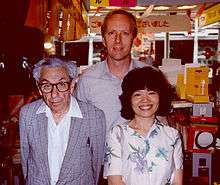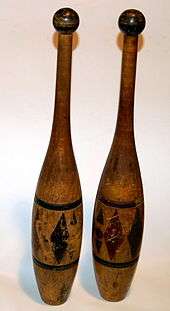Ronald Graham
| Ronald Graham | |
|---|---|
 Ronald Graham in 1998 | |
| Born |
October 31, 1935 Taft, California |
| Alma mater | University of California, Berkeley |
| Known for | combinatorics, information science, graph theory, scheduling theory |
| Scientific career | |
| Fields | mathematics, computer science |
| Institutions | Bell Labs, AT&T Labs |
| Doctoral advisor | Derrick Henry Lehmer |
Ronald Lewis "Ron" Graham (born October 31, 1935)[1] is an American mathematician credited by the American Mathematical Society as being "one of the principal architects of the rapid development worldwide of discrete mathematics in recent years".[2] He has done important work in scheduling theory, computational geometry, Ramsey theory, and quasi-randomness.[3]
He is currently the Chief Scientist at the California Institute for Telecommunications and Information Technology (also known as Cal-(IT)2) and the Irwin and Joan Jacobs Professor in Computer Science and Engineering at the University of California, San Diego (UCSD).
Biography
Graham was born in Taft, California. In 1962, he received his Ph.D. in mathematics from the University of California, Berkeley and began working at Bell Labs and later AT&T Labs.[4] He was director of information sciences in AT&T Labs, but retired from AT&T in 1999 after 37 years.
His 1977 paper considered a problem in Ramsey theory, and gave a large number as an upper bound for its solution. This number has since become well known as the largest number ever used in a mathematical proof (was listed as such in the Guinness Book of Records), and is now known as Graham's number, although it has since then been surpassed by even larger numbers such as TREE(3).
Graham popularized the concept of the Erdős number, named after the highly prolific Hungarian mathematician Paul Erdős (1913–1996). A scientist's Erdős number is the minimum number of coauthored publications away from a publication with Erdős. Graham's Erdős number is 1. He co-authored almost 30 papers with Erdős, and was also a good friend. Erdős often stayed with Graham, and allowed him to look after his mathematical papers and even his income. Graham and Erdős visited the young mathematician Jon Folkman when he was hospitalized with brain cancer.[5]

Between 1993 and 1994 Graham served as the president of the American Mathematical Society. Graham was also featured in Ripley's Believe It or Not for being not only "one of the world's foremost mathematicians", but also "a highly skilled trampolinist and juggler", and past president of the International Jugglers' Association.

He has published about 320 papers and five books, including Concrete Mathematics with Donald Knuth and Oren Patashnik.[6]
He is married to Fan Chung Graham (known professionally as Fan Chung), who is the Akamai Professor in Internet Mathematics at the University of California, San Diego.
Awards and honors
In 2003, Graham won the American Mathematical Society's annual Steele Prize for Lifetime Achievement. The prize was awarded on January 16 that year, at the Joint Mathematics Meetings in Baltimore, Maryland. In 1999 he was inducted as a Fellow of the Association for Computing Machinery. Graham has won many other prizes over the years; he was one of the laureates of the prestigious Pólya Prize the first year it was ever awarded, and among the first to win the Euler Medal. The Mathematical Association of America has also awarded him both the Lester R. Ford prize which was "...established in 1964 to recognize authors of articles of expository excellence published in The American Mathematical Monthly...",[7] and the Carl Allendoerfer prize which was established in 1976 for the same reasons, however for a different magazine, the Mathematics Magazine.[8] In 2012 he became a fellow of the American Mathematical Society.[9]
Books
- with Paul Erdős: Old and new results in combinatorial number theory. L’Enseignement Mathématique, 1980
- with Fan Chung: Erdős on Graphs. His legacy of unsolved problems. A. K. Peters, 1998
- with Jaroslav Nešetřil (ed.): The mathematics of Paul Erdős. 2 vols. Springer, 1997
- Rudiments of Ramsey Theory. American Mathematical Society, 1981
- with Donald E. Knuth & Oren Patashnik: Concrete Mathematics: a foundation for computer science. Addison-Wesley, 1989; 1994
- with Joel H. Spencer & Bruce L. Rothschild: Ramsey Theory. Wiley, 1980;[10] 1990
- with Martin Grötschel & László Lovász (ed.): Handbook of Combinatorics. MIT Press, 1995
- with Persi Diaconis: Magical Mathematics: the mathematical ideas that animate great magic tricks. Princeton University Press, 2011 (won the Euler Book Prize)
- Rudiments of Ramsey Theory, Second Edition, American Math Society, (2015)
See also
References
- ↑ O'Connor, John J.; Robertson, Edmund F., "Ronald Graham", MacTutor History of Mathematics archive, University of St Andrews .
- ↑ "2003 Steele Prizes" (PDF). Notices of the AMS. Vol. 50 no. 4. American Mathematical Society. April 2003. pp. 462–467. Archived from the original (PDF) on 26 December 2010. Retrieved 2 July 2014.
- ↑ Horgan, J. (1997). "Profile: Ronald L. Graham – Juggling Act". Scientific American. Nature Publishing Group. 276 (3): 28–30. doi:10.1038/scientificamerican0397-28.
- ↑ Larry Rabiner (4 Feb 2000). "Ron Graham – A Biographical Retrospective" (PDF).
- ↑ Hoffman, Paul (1998), The man who loved only numbers: the story of Paul Erdős and the search for mathematical truth, Hyperion, pp. 109–110, ISBN 978-0-7868-6362-4 .
- ↑ Butler, Steve (23 July 2008). "Papers of Ron Graham". UCSD Mathematics. Retrieved 2 July 2014.
- ↑ "The Mathematical Association of America's The Paul R. Halmos-Lester R. Ford Award". Mathematical Association of America. Archived from the original on 2 July 2013. Retrieved 2 July 2014.
- ↑ "Allendoerfer Award". Mathematical Association of America. Retrieved 2 July 2014.
- ↑ "List of Fellows of the American Mathematical Society". American Mathematical Society. Retrieved 19 January 2013.
- ↑ Faudree, Ralph (1982). "Review: Ramsey Theory, by Ronald L. Graham, Joel H. Spencer, and Bruce L. Rothschild" (PDF). Bull. Amer. Math. Soc. Providence, RI: American Mathematical Society. 6 (1): 113–116. Retrieved 2 July 2014.
External links
- Graham's UCSD Faculty Research Profile
- Papers of Ron Graham – a comprehensive archive of the papers written by Ron Graham
- About Ron Graham – a page summarizing some aspects of Graham's life and mathematics – part of Fan Chung's website
- "Math expert coolly juggles scientific puzzles and six or seven balls" – a SignOnSanDiego.com article on Graham, by Bruce V. Bigelow, dated March 18, 2003
- AMS news release telling of Graham's winning of the 2003 Steele Prize
- Ronald Graham at the Mathematics Genealogy Project
- MAA presidents: Ronald Lewis Graham
